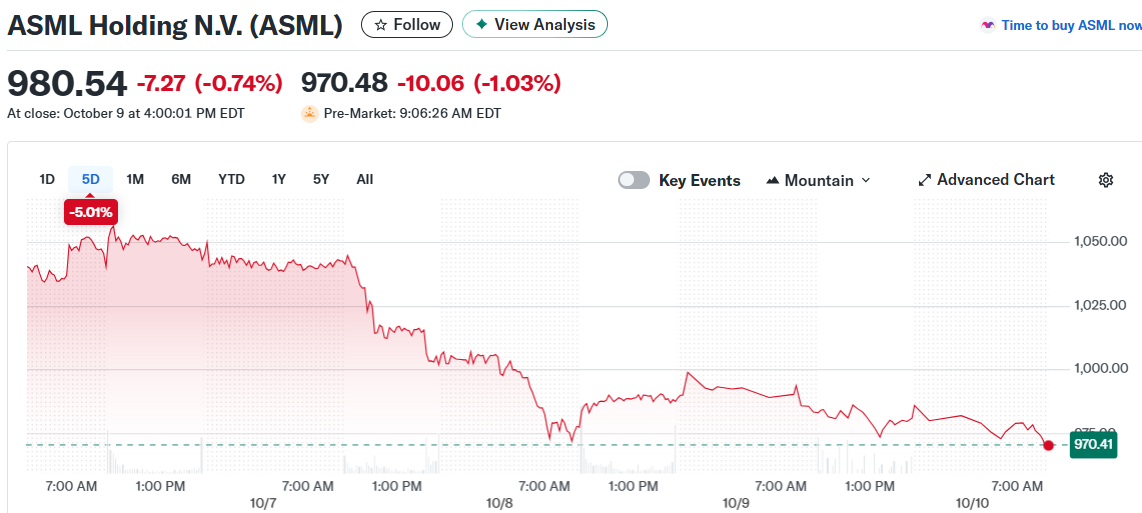TLDR
- AMD jumped 23.7% on October 6 after announcing a deal with OpenAI for up to 6 gigawatts of GPUs and a 10% stake investment.
- OpenAI is working with multiple chip companies including Nvidia ($100 billion deal), Broadcom ($10 billion order), and AMD to reach its 10 GW data center goal.
- ASML manufactures the most advanced photolithography machines needed for AI chip production, with a near-monopoly on extreme ultraviolet (EUV) systems.
- ASML’s equipment costs hundreds of millions per machine and lasts for decades, with 95% of systems sold in the past 30 years still active.
- EUV machines are essential for manufacturing high-performance AI chips, positioning ASML to benefit from sustained AI infrastructure spending regardless of which chipmaker wins contracts.
AMD caught fire on October 6, jumping 23.7% after revealing a deal with OpenAI. The hyperscaler is taking up to a 10% stake in AMD and ordering 6 gigawatts of GPUs.

But AMD isn’t the only chipmaker getting a piece of OpenAI’s massive infrastructure push.
OpenAI is spreading its bets across multiple suppliers. Nvidia landed a $100 billion partnership in late September. Broadcom likely secured a $10 billion order when it reported earnings in early September.
The first gigawatt of AMD Instinct MI450 GPUs should arrive in the second half of 2026. That’s the same timeline as Nvidia’s deployment.
OpenAI is chasing 10 gigawatts of data center capacity purpose-built for AI. Getting there means working with every major chip company.
Broadcom brings something different to the table. Its XPU accelerators are custom ASICs designed for specific tasks. GPUs from AMD and Nvidia are more versatile for training and inference work.
The cloud computing side is getting crowded too. OpenAI formed a $300 billion deal with Oracle. But Microsoft Azure remains in the picture.
Why ASML Benefits From Every Deal
Here’s where it gets interesting for ASML investors. No matter which chipmaker wins what contract, they all need the same thing.
ASML makes the photolithography machines that print circuit designs onto silicon wafers. These machines are essential for modern chip production.
When OpenAI buys chips from AMD, Nvidia, or Broadcom, those companies turn to Taiwan Semiconductor Manufacturing with their designs. Taiwan Semi then uses ASML equipment to manufacture the chips.
ASML isn’t designing or making chips. But it’s impossible to make advanced chips without their machines.
The company produces deep ultraviolet machines that most manufacturers use. But ASML’s real edge comes from extreme ultraviolet machines.
EUV systems use mirrors instead of lenses to achieve smaller wavelengths. That lets them print more precise features on chips.
These machines cost hundreds of millions of dollars each. Transport and assembly can take months or years. But they’re becoming essential for handling growing AI chip volumes.
The Equipment Advantage
ASML holds a near-monopoly on EUV technology. Applied Materials and Lam Research compete in the broader semiconductor equipment space. Taiwan Semi competes as a foundry.
But when it comes to the most advanced lithography systems, ASML stands alone.
The company reported in 2023 that 95% of lithography systems sold over 30 years remain active. These machines don’t just last a long time. They lock customers into long-term service contracts.
Once a semiconductor manufacturer installs costly ASML systems, switching providers becomes impractical. Even if alternatives existed.
EUV machines currently make up a smaller portion of ASML’s sales mix. As production ramps up and AI chip orders grow, that should change. Higher EUV sales should drive margin expansion and revenue growth.
ASML stock trades at a forward price-to-earnings ratio of 33. That’s just below its five-year average of 34. The price-to-sales ratio sits at 11.
The stock has a beta of 1.28, making it 28% more volatile than the overall market.
Over the past 10 years, ASML shares averaged annual gains of 27.7%. A $5,000 investment would have grown to more than $57,000.
The company’s market cap stands at $380 billion. AMD’s market cap is $378 billion after the recent surge.
AMD’s first gigawatt of Instinct MI450 GPUs for OpenAI is set to deploy in the second half of 2026.
Stay Ahead of the Market with Benzinga Pro!
Want to trade like a pro? Benzinga Pro gives you the edge you need in today's fast-paced markets. Get real-time news, exclusive insights, and powerful tools trusted by professional traders:
- Breaking market-moving stories before they hit mainstream media
- Live audio squawk for hands-free market updates
- Advanced stock scanner to spot promising trades
- Expert trade ideas and on-demand support



